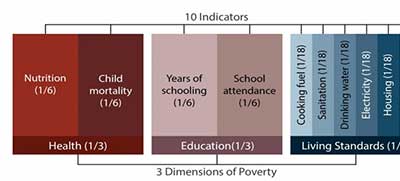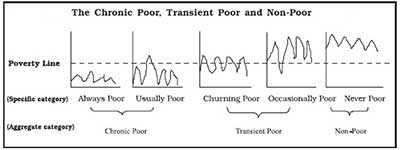GS-1: Poverty and Developmental issues
Key phrases: Poverty, HDI, Inequality, Multidimensional Poverty Index, NFHS
Why in news:
The recently released NFHS data gives insights into Poverty and Inequality existing in India along with the improvements seen in few states.
Analysis:
- Global studies on poverty started with the World Bank’s income/consumption-based measure of absolute poverty.
- The UN expanded the monetary index adding health and education indicators via the Human Development Index (HDI).
- The MPI is third in the series of global studies on poverty; it is an Oxford-based initiative that develops an exclusive broadly non-monetary living standard index of poverty.
Poverty:
United Nations definition of poverty:
- Fundamentally, poverty is the inability of having choices and opportunities, a violation of human dignity.
- It means a lack of basic capacity to participate effectively in society.
- It means not having enough to feed and clothe a family, not having a school or clinic to go to, not having the land on which to grow one's food or a job to earn one's living, not having access to credit.
- It means insecurity, powerlessness and exclusion of individuals, households and communities.
- It means susceptibility to violence, and it often implies living in marginal or fragile environments, without access to clean water or sanitation.
World Bank definition of poverty:
- Poverty is pronounced deprivation in well-being, and comprises many dimensions.
- It includes low incomes and the inability to acquire the basic goods and services necessary for survival with dignity.
- Poverty also encompasses low levels of health and education, poor access to clean water and sanitation, inadequate physical security, lack of voice, and insufficient capacity and opportunity to better one's life.
Amartya Sen's definition of poverty:
- According to Sen, being poor does not mean living below an imaginary poverty line, such as an income of two dollars a day or less.
- It means having an income level that does not allow an individual to cover certain basic necessities, taking into account the circumstances and social requirements of the environment.
Types of poverty:
- Absolute Poverty: It is a condition characterised by severe deprivation of basic human needs, including food, safe drinking water, sanitation facilities, health, shelter, education and information. It depends not only on income but also on access to services. It was first introduced in 1990 the “dollar a day poverty line” to measure absolute poverty.
- Relative Poverty: Relative poverty is the condition in which people lack the minimum amount of income needed in order to maintain the average standard of living in the society in which they live.
Hence it is a measure of income inequality.
Inequality:
The United Nations describes inequality as “the state of not being equal, especially in status, rights and opportunities.
- Inequality can have many dimensions like economic inequality- unequal distribution of wealth, income and opportunities
- social inequality- inequalities in the societal level like religion, gender, caste, race, etc.
Human Development Index:
The Human Development Index (HDI) is a summary measure of average achievement in key dimensions of human development:
- a long and healthy life,
- being knowledgeable and
- having a decent standard of living.

The HDI is the geometric mean of normalized indices for each of the three dimensions. HDI is released by the United Nations Development Program(UNDP).
Global Multidimensional Poverty Index
- It is released by the United Nations Development Program(UNDP) and Oxford Poverty and Human Development Initiative(OPHI).
- The index considers 109 countries and 5.9 billion people.
- MPI is based on the idea that poverty is not unidimensional (not just depends on income and one individual may lack several basic needs like education, health etc.), rather it is multidimensional.
- The index shows the proportion of poor people and the average number of deprivations each poor person experiences at the same time.
- MPI is based on three dimensions and 10 indicators:
- Education: Years of schooling and child enrollment;
- Health: Child mortality and nutrition;
- Standard of living: Electricity, flooring, drinking water, sanitation, cooking fuel and assets

A person is multi-dimensionally poor if she/he is deprived in one third or more (means 33% or more) of the weighted indicators (out of the ten indicators). Those who are deprived in one half or more of the weighted indicators are considered living in extreme multidimensional poverty.
NITI Aayog calculation of Poverty: National’s Multidimensional Poverty Index:
- The National Multidimensional Poverty Index (NMPI) baseline report defines poverty as the deprivation in crucial and basic parameters of health, education and living standards.
- It is based on National Family Health Survey 4 (NFHS-4), which was conducted between 2015 and 2016.
- It is calculated using 12 indicators -- nutrition, child and adolescent mortality, antenatal care, years of schooling, school attendance, cooking fuel, sanitation, drinking water, electricity, housing, assets and bank account that have been grouped under three dimensions namely, health, education and standard of living.
What NFHS data tells about Inequality:
- Uttar Pradesh has 37.8 percent of the population below MPI poverty level; whereas Kerala has 0.71 percent of the population below MPI poverty.
- Higher improvement by less developed states is evidence in support of catch-up, which suggests that regional imbalances are reducing.
- States such as UP, Bihar and Jharkhand are fast approaching similar standards for select indicators as some of the “developed” states.
- The reasons for improvement seen in poverty and inequality includes many interventions by the government such as:
• Sanitation - this was directly addressed by the construction of 110 million toilets.
• The problem of asthma due to indoor air pollution generated by incomplete combustion of wood used for cooking was addressed by the PM Ujjwala Yojana which provided 86 million LPG connections.
• MGNREGA has also contributed to lift the rural poor.
• The approach was not just limited to sanitation, proper fuel or electricity- interventions that are targeted to an individual household, but also to the holistic development of an entire region.
• This was the central theme behind the identification of the most backward districts of the country and targeting public resources to help them catch up with the India growth story.
Way forward
The problem of Poverty in India is catastrophic. We can’t ignore it because 2/3rd of people in India live in poverty.
Major ways to reduce poverty are:
- Education: Schemes like Samagra Shiksha Abhiyan have to be implemented with full spirit, education is the key for empowerment.
- Infrastructure development: infrastructure development has a multiplier effect on the economy thereby reducing poverty.
- Entrepreneurship and Skill Development: Skill development and vocational training are very important to address unemployment in the country to reduce poverty.
- Health: Health is wealth. Only a healthy person can earn the bread for a family to bring them above the poverty line. PM-JAY has to be made accessible to the poor sections of the country.
- Agricultural development: Agricultural stagnation and disguised unemployment are the reasons for the rural sector to be poor and hence scientific methods and developments in the Agri sector are the need of the hour.
Source: Indian Express
Prelims question:
Q. With reference to the history of identification of the poor people in India, consider the following statements:
- Dadabhai Naoroji was the first in pre-independence India to discuss the concept of a Poverty Line.
- In 1962, the Planning Commission now called as NITI Aayog formed a Study Group
- In 1989 and 2005, ‘Expert Groups’ were constituted for the same purpose.
Which of the statements given above are correct?
(a) 1 and 2 only
(b) 2 and 3 only
(c) 1 and 3 only
(d) 1, 2 and 3
Answer: (d)







